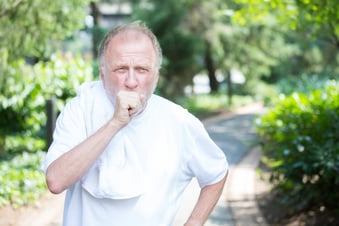 COPD is a painful condition that can slowly limit a person's ability to breathe and move. However, exercise can help to slow the progression of this disease and may even improve a person's strength and mobility. The following guide will help anyone with COPD start a beneficial exercise routine.
COPD is a painful condition that can slowly limit a person's ability to breathe and move. However, exercise can help to slow the progression of this disease and may even improve a person's strength and mobility. The following guide will help anyone with COPD start a beneficial exercise routine.
Exercising is Smart for Those With COPD
Individuals with COPD benefit from exercise in a multitude of ways. First of all, exercise helps to increase the efficiency of oxygen use, a benefit that is crucial for anybody with this challenging disease. Exercise also helps to increase a person's walking distance, improves their overall strength, and minimizes their occurrence of shortness of breath. Routines should last no more than 30 minutes.
Beyond these physical benefits, exercise also helps to manage the kind of anxiety and depression that commonly affects those with COPD. As a person exercises, they increase their blood flow through the body and bring oxygen to the brain and other parts of the body. As a result, even cognitive functions – such as memory and hand-eye-coordination – can improve.
Exercise Should Follow a Pattern
Whenever a person exercises, they should follow a three-part plan. However, those with COPD should make sure to monitor their oxygen intake and stop if they feel exhausted or unable to breathe when performing this routine:
- Warm-Up – A slow warm-up period of about two or three minutes helps to prepare your muscles and your body for the intensity of exercise. Those with COPD, in particular, need a warm-up period to help the lungs prepare and to gauge their ability to workout.
- Conditioning – The conditioning phase is where the most intense period of exercise takes place. During these 15 minutes, you'll work your body to its limit. Make sure that you track your breath while working out and stop if you feel short of breath or too tired to continue.
- Cool-Down – Once you finish the conditioning period, a two to three-minute cool-down is recommended. In a sense, the cool-down is the opposite of a warm-up. Walk in place slowly to bring your heart rate down and to relax your muscles. Skip this step if your COPD is too severe at the moment.
Exercises That Help Those With COPD
High-quality COPD exercises should improve a person's flexibility, cardiovascular health, and muscle strength. This three-part approach helps a person manage their COPD in many ways and may provide them with stronger and more stable resistance to this disease. The following sections discuss what types of exercises you should perform if you have COPD.
Stretches: Before and After Extended Routines
Stretching the muscles is a smart move before and after exercise. Long and slow lengthening of the muscles helps to increase their strength and keeps them flexible enough to handle more in-depth exercise routines. Just as importantly, they prevent cramps from affecting the muscles.
Those with COPD should stretch for at least three to five minutes or so, including extending their arms, legs, back, neck, and core muscles. Arm lifts and waist bends are particularly useful in this situation. They help to get the blood flowing to different parts of the body and increase oxygen use efficiency.
Cardiovascular Routines: Every Day
Improving a person's cardiovascular health will help them better manage their symptoms of COPD. However, the unique strain this disease causes on the body may make this the most challenging type of exercise to perform. Therefore, it is a good idea to take it slow but to work up to an intensity of exercise that feels right for the person.
Walking is a good starter exercise for somebody with COPD. Take a stroll through your neighborhood for 30 minutes and breathe slowly and carefully while you walk. Talk to your doctor about increasing exercise difficulty to include routines such as biking, jogging, skating, or even water aerobics.
Strengthening: Every Other Day
Increasing the strength of the muscles helps a person with COPD fight off fatigue and improves the flow of oxygen-rich blood through their body. These types of exercises should be performed only every other day, though, as the body needs time to recover and rebuild the muscles after a routine.
Strength routines can include weight lifting and resistance exercises, such as tightening bands. Start with a low level of weight and resistance to get a feel for what your body can handle. Try to push just a little beyond your limits to improve your muscle strength. But, as always, stop if you feel exhausted or unable to proceed.
Gauge Your Exhaustion
The outpatient AIRE Program (Accessible Intervention and Respiratory Education) at Orchard Hospital is available to help you gain knowledge of your lung disease, manage your breathing problems and improve your exercise tolerance. In turn, this will help you to achieve your optimal ability to carry out activities of daily living, regain independence and improve your overall quality of life.
At Orchard Hospital's Medical Specialty Center—Your Everyday Health Care Clinic, we work with people who have COPD almost every day. We also understand that, sometimes, you don't feel up to working out. However, it is typically safe to exercise if you feel tired, lazy, have a headache, or don't feel like working. These reasons shouldn't limit your exercise ability and can be avoided if you do work out.
However, our walk-in clinic has also worked with people who feel nauseous, chest pains, fevers, severe leg pains, or a complete lack of oxygen while exercising. These individuals with COPD should stop exercising right away and come to our clinic to ensure that they haven't injured themselves.
Remember: exercise with COPD is beneficial but should be done with care and attention to the demands of this disease.
Schedule an appointment or visit us today!



